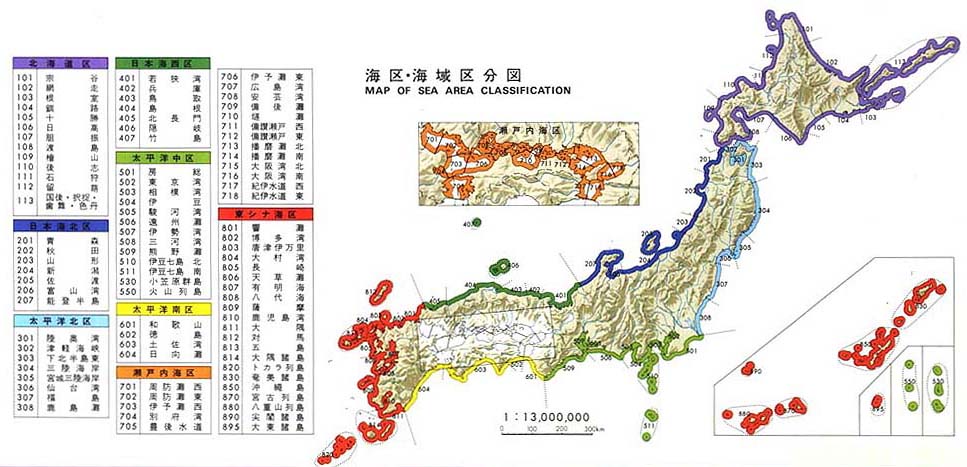
|
海域の自然環境 MARlNE ENVIRONMENT |
||
|
|
||
|
日本は周囲を完全に海に囲まれた海洋国である。また、国土面積に対して海岸線延長が極めて長く、その形態も多様性に富むため、日本の生物相は海との関係が深い。海はあらゆる生命の源と呼ばれるとおり、生物にとって重要な生息地であるとともに、人間にとっては古くからの生活域である。とりわけ海岸域は、生物にとっても人間にとっても重要な場所である。わが国の都市の拡大と工業立地は、近年特に海岸域に集中したため、自然環境保全上の諸問題もここに集積されている。 ここでは、日本の海域の中でも特に海岸域の自然環境について、主として人間による改変の状況と生物の分布の概要を明らかにする。日本列島の海岸線の改変状況から始って、干潟・藻場・サンゴ礁の分布、ついで潮間帯の生物やこれまで記録されている赤潮の発生状況について示す。 |
The Japanese Archipelago has, relative to its size, very long coastal lines which are very variable, and its biosphere is closely related to the marine environment. The marine area is an important habitat for many living organisms, and is also an important area for human life. Despite this importance, the development of urban areas and industrial sites has been concentrated in coastal areas, especially in recent years, and problems in nature conservation are also acute in these areas. Here, alteration of the natural environment and the distribution of organisms in coastal areas are summarized. The present state of alteration of coastal lines, distribution of tidal beaches, algal communities and coral reefs, living organisms of the tidal zone, and a record of the occurrence of red tide are included in this chapter. |
|
|
42.
|
SEACOAST OF JAPAN |
||
|
海岸の概要 多くの島々からなる日本列島の海岸線は、湾や岬が多く、複雑で屈曲に富んでおり、その総延長は約32,000kmに達する。大局的にみれば、太平洋側の海岸線は多くの湾入部をもち複雑に屈曲しているのに対し、日本海側は比較的単調で直線的である。 このような日本の海岸は、その形態を地形・地質の特性から、砂浜(砂質)海岸と岩石海岸に大別することができる。砂浜海岸は河川の河口付近に広く発達し、太平洋側では東京湾、伊勢湾、大阪湾などの内湾にも多い。日本海側では北陸以北に多く分布し、海岸砂丘の発達とも関連深い。この海岸砂丘は、比較的大きな河川が流入して土砂の供給の多い海岸に分布する。とくに、日本海側では冬期に強風が長期間連続して吹くので、砂丘の発達がよい。一方、半島や岬では岩石海岸となり、岬と岬のあいだには小さなポケット・ビーチをともなうところもある。岩石海岸は三陸地方、紀伊半島以西の太平洋側、若狭湾、九州西岸などで長くつづく。また、伊豆諸島やトカラ列島などの火山島をはじめとして、火山体あるいは火山噴出物が海岸をつくるところも多い。さらに、南西諸島にはサンゴ礁海岸が発達する。 海岸の改変 日本の海岸は地形・地質的に多種多様であるとともに、人工改変されている割合が高い。都市化・工業化にともなう土地利用の高度化、つまり臨海平野への人口集中、港湾や臨海工業地帯の開発と整備、道路・鉄道網の発達などが沿岸域を中心におこなわれたために、自然の形態を保つ海岸線は全体の約60%しか残っていない。全体の約27%は提防・護岸などの人工構造物からなるまったくの人工海岸で、残りの13%も何らかの意味で人間の手が加えられている半自然海岸である。このような海岸の人工改変は、埋立・干拓による干潟の急速な減少をともない、また沿岸地域の開発が進むにつれて、地盤沈下によるゼロメートル地帯の拡大や海岸侵食の進行がみられる。このことは波浪・高潮・津波などによる海岸災害の危険度がますことにつながる。 自然状態のもとでは、山地からの多量の土砂の供給により海岸線は前進する可能性があり、事実過去約6,000年のあいだに日本の海岸平野の大部分が形成された。しかし、第二次大戦後、大河川の河口付近では大規模な海岸侵食が目立ちはじめた。これは、おもに人工的・社会的要因によるところが大きく、具体的には河川に建設されたダム・貯水池における堆砂や河床からの砂利採取などにより、堆積物供給量が減少したこと、海岸の防波堤・河口の導流堤の築造や放水路の掘削などによって漂砂の平衡が破れたことなどがあげられる。海岸侵食から、国土の保全と人命の安全をはかるために、海岸堤防・護岸・突堤群・離岸堤などが建設されている。また津波・高潮対策として、堤防・護岸のほかに防波堤が湾口・湾央部に築かれている。 (米倉 伸之) |
General Description The coastline of the Japanese Archipelago is very rugged and complex with many bays and capes, and its total length amounts to about 32,000 kilometers. The coastline of the Pacific side is complicated with many bays and peninsulas, while the Japan Sea side is rather monotonous. Sand beaches develop generally near estuaries, but many are found also inside bays like those of Tokyo, Ise, and Osaka, on the Pacific side. On the Japan Sea side, many sand beaches are found in the northern parts and some of them have sand dunes. Sand dunes develop where much sand is supplied by large rivers. On the Japan Sea side, which is exposed to strong winds from the northwest continuously during the wintertime, sand dunes develop on many coasts. Rocky coasts are usual on peninsulas and capes, and small bays lie between capes. There are many volcanic islands like the Izu and Tokara Islands where volcanos themselves or their ejecta form the seacoasts. In the Ryukyu Archipelago coral reefs develop. Alteration of Seacoast However, many parts of the coastline have been altered by man and only about 60 per cent of them retain their natural landscape. Recent rapid industrial growth has resulted in the concentration of population in coastal plains and in the development of seaside industrial areas with port facilities. New roads and railroads have also been constructed along seacoasts. These developmental works have altered 40 per cent of the Japanese coastline, of which 27 per cent is artificial constructions like embankments and the other 13 per cent is semi-natural coasts with alteration by man in one way or another. Alteration of seacoast by man, like land reclamation, is accompanied by a rapid decrease of tidal beaches. With progress of exploitation in coastal areas, expanision of the land areas below sea level and progress of erosion of seacoasts due to sinking of ground took place. These increased in turn susceptibility to the hazards from surf, high tides, and tidal waves. It is said that many construction works on seacoasts are repairs of or countermeasures against these calamities. Under natural conditions, it is proble that the coastline advances by the large supply of sands from mountains and hills. In fact, most of the coastal plains in Japan were formed in this way, during the past six thousand years. However, after World War Ⅱ, erosion of the seacoast began to appear near estuaries of large eivers. This is not a natural outcome but mostly a consequence of human activities. The reasons for this erosion, are decrease of the supply of sand due to construction of dams and reservoirs and to collection of sand and gravels from river beds, and the disturbance of coastal currents which carry drifting sands due to a variety of constructions along or off the shore including embankments, moles, drainage canals, etc. As countermeasures against this kind of erosion for human safety and conservation of landscape, in turn, a variety of constructions are being done, such as coastal embankments, dikes, jetties, etc. Breakwaters and moles are constructed on bays and inlets against high tides and tidal waves. (Nobuyuki Yonekura) |
||
|
|